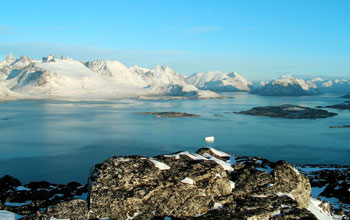Media Advisory 11-013
NSF Invites Media to Apply for July Visit to Arctic Field Research Sites in Greenland
Application deadline is June 20, 2011; deployments to take place between July 12 and July 19, 2011
June 7, 2011
This material is available primarily for archival purposes. Telephone numbers or other contact information may be out of date; please see current contact information at media contacts.
The National Science Foundation (NSF) is accepting written requests from professional journalists to report on research--including studies of the ice sheet, climate change and atmospheric chemistry--supported in Greenland by NSF's Office of Polar Programs (OPP).
OPP and NSF's Office of Legislative and Public Affairs (OLPA) jointly manage and coordinate media visits to the Polar Regions.
NSF supports numerous field research projects in Greenland, many of which are international in scope. NSF will select a small group of journalists to visit the Greenland Environmental Observatory, Summit (GEOSummit) and other remote sites in Greenland--as weather permits--that represent the range of science in the area. Journalists would deploy between July 12 and 19, 2011.
Example projects related to climate and environmental chemistry will be open to media visits:
- The Greenland Ice Sheet is undergoing remarkable changes, as evidenced by surface melt ponds and glacial retreat. Scientists are studying the ice sheet to gather information that will allow them to understand past climate trends and conditions as well as present surface-melt and river runoff patterns and properties of fast-moving tidewater glaciers.
- The sun's impact on the ice sheet is exacerbated by aerosols from burning of biomass, fossil fuels and dust. How much impact the sun has on the ice sheet by being absorbed rather than reflected by aerosols is the subject of several studies.
- An international team of researchers led by the University of Copenhagen are drilling ice core at the North Greenland Eemian Ice Drilling project to understand the Eemian warm period about 130,000 to 114,000 years ago--a period with a climate much like the present.
How to apply: Applicants must submit the equivalent of two printed pages detailing specifically what they intend to cover while in the field. NSF public affairs officers can help applicants to craft a proposed reporting plan that has the best chance of meeting minimum criteria.
A selection committee of Division of Arctic Sciences personnel and media officers from OLPA will review all proposals and select finalists. The committee will look for proposals that indicate an understanding of the nature and challenges of NSF's scientific enterprise in the Arctic and the desire and ability to communicate that understanding to the public.
Application Deadline: Monday, June 20, 2011--U.S. media receive preference in selection.
Application: Focused applications with thorough reporting plans that indicate solid working knowledge of Greenland's science goals in the Arctic and an intent to highlight for the public the scientific discoveries taking place there stand the best chance of selection.
For additional background please go to the ARMAP and NSF's Summit Greenland Observatory websites.
Expenses: NSF furnishes at no cost cold-weather clothing, solely for use in the field, as well as housing, transportation and food while in the field. Trip expenses are estimated to be a roundtrip ticket to Albany, N.Y., one-night stay at the Hampton Inn in Schenectady, depending on the departure date, plus per-diem and cab fare to/from the airport.
How To Apply: Contact the NSF media officer listed below (by phone or by e-mail) as soon as possible to express interest. Freelancers are eligible for consideration but must supply with their letter of application evidence in written form of a firm commitment to publish or air their work.
Send the application letter to:
National Science FoundationOffice of Legislative and Public Affairs
4201 Wilson Boulevard, Suite 1245
Arlington, VA 22230
Attn: Debbie Wing
For further information regarding NSF and the Arctic programs, please visit the Arctic Sciences webpage.
-NSF-
Media Contacts
Debbie Wing, National Science Foundation, (703) 292-5344, email: dwing@nsf.gov
The U.S. National Science Foundation propels the nation forward by advancing fundamental research in all fields of science and engineering. NSF supports research and people by providing facilities, instruments and funding to support their ingenuity and sustain the U.S. as a global leader in research and innovation. With a fiscal year 2023 budget of $9.5 billion, NSF funds reach all 50 states through grants to nearly 2,000 colleges, universities and institutions. Each year, NSF receives more than 40,000 competitive proposals and makes about 11,000 new awards. Those awards include support for cooperative research with industry, Arctic and Antarctic research and operations, and U.S. participation in international scientific efforts.
Connect with us online
NSF website: nsf.gov
NSF News: nsf.gov/news
For News Media: nsf.gov/news/newsroom
Statistics: nsf.gov/statistics/
Awards database: nsf.gov/awardsearch/
Follow us on social
Twitter: twitter.com/NSF
Facebook: facebook.com/US.NSF
Instagram: instagram.com/nsfgov



